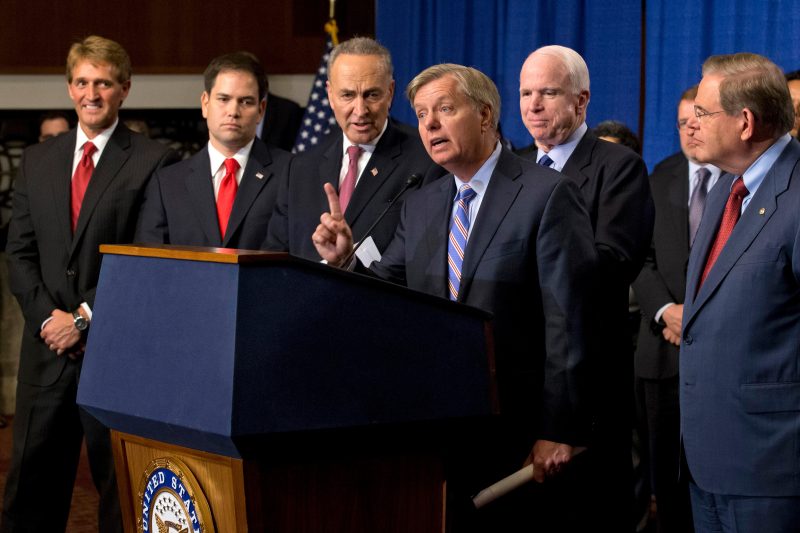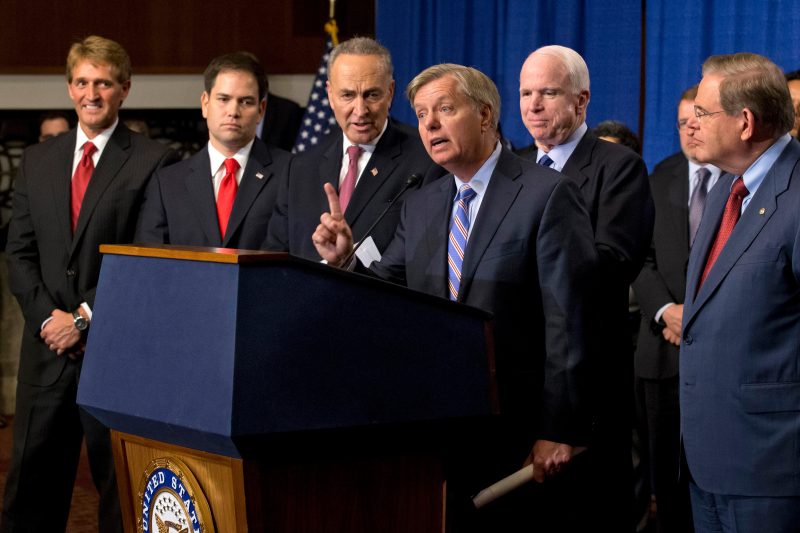
If the 2008 presidential election made Republicans nervous, the 2012 contest made them panic.
Barack Obama had easily defeated Sen. John McCain (R-Ariz.) in his first presidential race, but there were all sorts of ways that victory could be rationalized: President George W. Bush’s unpopularity and the economic crisis. Yes, Obama benefited from an emergent coalition of young and non-White voters, but maybe it was a one-off?
Despite widespread confidence on the right, Obama beat former Massachusetts governor Mitt Romney to win a second term in office. The same coalition showed up and the only incumbent on the ballot was Obama. Something had shifted, it seemed — and therefore needed to be addressed.
In an interview two days after the election, then-House Speaker John A. Boehner (R-Ohio) suggested that his party might engage in a targeted effort to appeal to non-White voters.
The issue of immigration, he said, “has been around far too long, and while I believe it’s important for us to secure our borders and to enforce our laws, I think a comprehensive approach is long overdue, and I’m confident that the president, myself, others, can find the common ground to take care of this issue once and for all.”
Fox News and radio host Sean Hannity had already offered a similar argument.
“If some people have criminal records, you can send them home,” he said, “but if people are here, law-abiding, participating for years, their kids are born here, you know, first secure the border, pathway to citizenship, done.”
Speaking to reporters that same month, Obama agreed. It seemed like a strategy was taking shape.
In January 2013, a group of eight senators — soon dubbed the “Gang of Eight” — announced a framework for immigration reform. There were four Republicans, including McCain, Sen. Lindsey Graham (R-S.C.) and Sen. Marco Rubio (R-Fla.). Hannity was a fan. Legislation was introduced and passed the Senate by a nearly 2-to-1 majority that June.
But by then everything was already falling apart. Conservative media — at first in opposition to Hannity and then with his participation — hammered the bill, particularly the pathway to citizenship. Rubio, who embraced his role as the GOP champion of the idea, traveled to New York in January with Sen. Charles E. Schumer (D-N.Y.) to plead with Fox News honchos Rupert Murdoch and Roger Ailes to give the legislation some breathing room. By June, that ship had sailed.
Washington Post-ABC News polling from July 2013 showed that only half the country backed the Senate bill. Seven in 10 Republicans opposed it. Instead of taking up the bill in the House, most respondents said it should be broken into pieces, which Boehner had already pledged. By October, even Rubio was advocating that approach instead of pushing for the House to work with the legislation the Senate had already passed.
The political floor had given out. By February 2014, even after his conference had offered tentative guidelines that included legal residency status for undocumented immigrants, Boehner rejected any plan that Obama might approve.
“There’s widespread doubt about whether this administration can be trusted to enforce our laws,” he said in a news conference. “And it’s going to be difficult to move any immigration legislation until that changes.”
Over 15 months, Boehner had gone from being receptive to reform to dismissing it — unquestionably in part because Republican voters were hostile. A CNN poll released in early February 2014 found that Republicans viewed stopping new immigration as a priority over providing a path to legal residency by a nearly 2-to-1 margin. It was an election year, and primaries were looming for his conference. House Majority Leader Eric Cantor (R-Va.) lost his primary to a relatively anonymous challenger in June. His position on immigration (and the fury it triggered in conservative media) was often cited as a cause.
A decade has passed, but all of this probably seems familiar. Sen. James Lankford (R-Okla.) took up the charge to help develop a comprehensive immigration plan that met his party’s desired outcomes and — surprisingly, given what Democrats had to concede — was successful. But the legislation quickly hit a buzz saw of opposition from the party’s base and antipathy from the Republican-led House. Lankford even suffered the same fate as Rubio did in 2015: disparaged by Donald Trump for having the gall to attempt a system overhaul.
“I’m legitimately surprised,” Lankford said in an interview on CNN on Tuesday, pointing to months of Republican rhetoric on the subject. Some of his colleagues had legitimate issues with the policy, he added, but “some are backing away also based on the politics of the moment.”
This should not be a surprise, certainly, given what unfolded after the 2012 election. In both cases, top-down efforts to develop an immigration compromise not only overestimated popular support but probably triggered a negative response. There is endless energy within the Republican base for opposing anything short of building a giant wall that keeps anyone from entering the United States. Reforming the system means to some extent accepting the system, and that’s an easy thing for the hard right to run against.
Trump, of course, went with the giant wall proposal. When he announced his candidacy in 2015, he piggybacked on the hostility to immigration within the Republican base that had been stoked by the failed effort at reform. He’s running again in 2024 and looking to do the same thing.

